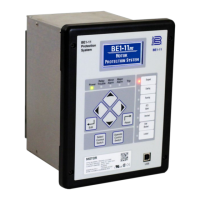1-6 9424200996
Introduction BE1-11m
Inverse Overcurrent (51) Protection
Five inverse overcurrent elements can be set for single-phase, three-phase, ground, neutral, positive-
sequence, negative-sequence, or unbalanced protection. Inverse-overcurrent functions employ a dynamic
integrating timing algorithm covering a range from pickup to 40 times pickup with selectable
instantaneous or integrated reset characteristics. Inverse time overcurrent curves conform to IEEE Std
C37.112-1996 - IEEE Standard Inverse-Time Characteristic Equations for Overcurrent Relays, and
include seven curves similar to Westinghouse/ABB CO curves, five curves similar to GE IAC curves, four
table curves, a fixed time curve, and a user programmable curve.
Negative-sequence current protection (46) is included as a mode of the 51 (inverse overcurrent) element.
A separate ground current input provides ground overcurrent protection for a separate ground CT.
Optionally, an SEF (sensitive earth fault) version of the separate ground CT is available.
BE1-11m protection systems enabled for IEC-61850 communication
(style Mxxxx5xxxxxxxx) do not allow voltage controlled or restrained
overcurrent elements. Blocking a 51 with an Undervoltage (27)
element may allow control pending application requirements.
Phase Current Differential (87) Protection
One phase current differential element provides three-phase, percentage-restrained, differential
protection with dual-slope, in-phase, differential mode. In flux balance mode, the differential CTs are
connected in a flux balancing configuration.
Power (32) Protection
A directional power element can be set for forward or reverse, overpower or underpower protection. The
element can be used for any application requiring directional power flow detection including intertie
protection (interconnects between an electric utility and a source of non-utility generation). The power
measurement algorithm is adapted as appropriate for any possible three-phase or single-phase voltage
transformer connection. Directional Power Protection can be set for one of three, two of three, three of
three, or total power.
m
protection systems enabled for IEC-61850 communication
(style Mxxxx5xxxxxxxx) have their power protection elements fixed at
one underpower element.
Loss of Excitation - Reverse Var Based (40Q) Protection
One loss of excitation element operates on excessive var flow into the machine, indicating abnormally low
field excitation.
Power Factor (55) Protection
A power factor element protects synchronous motors from receiving vars from the external power system
due to loss of field excitation.
Thermal Curve (49TC) Protection
A thermal curve element provides thermal protection of the motor with a current-based thermal model that
includes unbalanced current biasing, custom voltage-dependent curves, RTD biasing, and emergency
start override.

